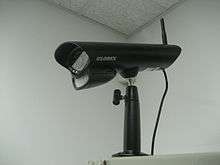Closed-circuit television
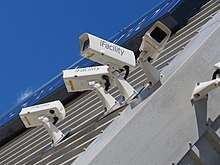

Closed-circuit television (CCTV), also known as video surveillance,[1][2] is the use of video cameras to transmit a signal to a specific place, on a limited set of monitors. It differs from broadcast television in that the signal is not openly transmitted, though it may employ point to point (P2P), point to multipoint (P2MP), or mesh wired or wireless links. Though almost all video cameras fit this definition, the term is most often applied to those used for surveillance in areas that may need monitoring such as banks, stores, and other areas where security is needed. Though Videotelephony is seldom called 'CCTV' one exception is the use of video in distance education, where it is an important tool.[3][4]
Surveillance of the public using CCTV is common in many areas around the world. In recent years, the use of body worn video cameras has been introduced as a new form of surveillance, often used in law enforcement, with cameras located on a police officer's chest or head.[5] Video surveillance has generated significant debate about balancing its use with individuals' right to privacy even when in public.[6][7]
In industrial plants, CCTV equipment may be used to observe parts of a process from a central control room, for example when the environment is not suitable for humans. CCTV systems may operate continuously or only as required to monitor a particular event. A more advanced form of CCTV, utilizing digital video recorders (DVRs), provides recording for possibly many years, with a variety of quality and performance options and extra features (such as motion detection and email alerts). More recently, decentralized IP cameras, some equipped with megapixel sensors, support recording directly to network-attached storage devices, or internal flash for completely stand-alone operation.
There are about 350 million surveillance cameras worldwide as of 2016. About 65% of these cameras are installed in Asia. The growth of CCTV has been slowing in recent years.[8]
History
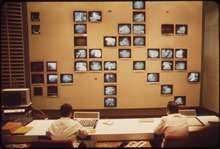
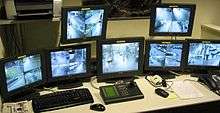


The first CCTV system was installed by Siemens AG at Test Stand VII in Peenemünde, Nazi Germany in 1942, for observing the launch of V-2 rockets.[9] The noted German engineer Walter Bruch was responsible for the technological design and installation of the system.[12]
In the U.S. the first commercial closed-circuit television system became available in 1949, called Vericon. Very little is known about Vericon except it was advertised as not requiring a government permit.[13]
Technology
The earliest video surveillance systems involved constant monitoring because there was no way to record and store information. The development of reel-to-reel media enabled the recording of surveillance footage. These systems required magnetic tapes to be changed manually, which was a time consuming, expensive and unreliable process, with the operator having to manually thread the tape from the tape reel through the recorder onto an empty take-up reel. Due to these shortcomings, video surveillance was not widespread. VCR technology became available in the 1970s, making it easier to record and erase information, and use of video surveillance became more common.[14]
During the 1990s, digital multiplexing was developed, allowing several cameras to record at once, as well as time lapse and motion-only recording. This increased savings of time and money which then led to an increase in the use of CCTV.[15]
Recently CCTV technology has been enhanced with a shift toward Internet-based products and systems, and other technological developments.[16]
Application
Closed-circuit television was used for professional boxing, as a form of pay-per-view theatre television. Boxing telecasts were broadcast live to a select number of venues, mostly theaters, where viewers paid for tickets to watch the fight live.[17][18] The first fight with a closed-circuit telecast was Joe Louis vs. Joe Walcott in 1948.[19] Closed-circuit telecasts peaked in popularity with Muhammad Ali in the 1960s and 1970s,[17][18] with "The Rumble in the Jungle" fight drawing 50 million CCTV viewers worldwide in 1974,[20] and the "Thrilla in Manila" drawing 100 million CCTV viewers worldwide in 1975.[21] Closed-circuit television was gradually replaced by pay-per-view home cable television in the 1980s and 1990s.[18]
In September 1968, Olean, New York was the first city in the United States to install video cameras along its main business street in an effort to fight crime.[22] Another early appearance was in 1973 in Times Square in New York City.[23] The NYPD installed it in order to deter crime that was occurring in the area; however, crime rates did not appear to drop much due to the cameras.[23] Nevertheless, during the 1980s video surveillance began to spread across the country specifically targeting public areas.[15] It was seen as a cheaper way to deter crime compared to increasing the size of the police departments.[23] Some businesses as well, especially those that were prone to theft, began to use video surveillance.[23] From the mid-1990s on, police departments across the country installed an increasing number of cameras in various public spaces including housing projects, schools and public parks departments.[23] CCTV later became common in banks and stores to discourage theft, by recording evidence of criminal activity. In 1998, 3,000 CCTV systems were in use in New York City.[24] A study by Nieto in 2008 found many businesses in the United States had invested heavily in video surveillance technology to protect products and promote safe workplace and consumer environments. A nationwide survey of a wide variety of companies found that 75 percent utilize CCTV surveillance. In private sector CCTV surveillance technology is operated in a wide variety of establishments such as in industry/manufacturing, retailing, financial/insurance/banking, transportation and distribution, utilities/communications, health care, and hotels/motels, parking areas, jewelry shops.
Experiments in the UK during the 1970s and 1980s, including outdoor CCTV in Bournemouth in 1985, led to several larger trial programs later that decade. The first use by local government was in King's Lynn, Norfolk, in 1987.[25] These were deemed successful in the government report "CCTV: Looking Out For You", issued by the Home Office in 1994, and paved the way for an increase in the number of CCTV systems installed. Today, systems cover most town and city centres, and many stations, car-parks and estates.
Uses
Crime prevention

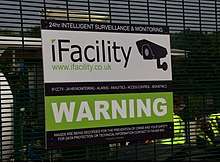
A 2009 systematic review by researchers from Northeastern University and University of Cambridge used meta-analytic techniques to pool the average effect of CCTV on crime across 41 different studies.[26] The results indicated that
- CCTV caused a significant reduction of crime by on average 16%.
- The largest effects of CCTV were found in car parks, where cameras reduced crime by on average 51%.
- CCTV schemes in other public settings had small and non-statistically significant effects on crime: 7% reduction in city and town centers and 23% reduction in public transport settings.
- When sorted by country, systems in the United Kingdom accounted for the majority of the decrease; the drop in other areas was insignificant.
The studies included in the meta-analysis used quasi-experimental evaluation designs that involve before-and-after measures of crime in experimental and control areas.[26] However, several researchers have pointed to methodological problems associated with this research literature. First, researchers have argued that the British car park studies included in the meta-analysis cannot accurately control for the fact that CCTV was introduced simultaneously with a range of other security-related measures.[27] Second, some have noted that, in many of the studies, there may be issues with selection bias since the introduction of CCTV was potentially endogenous to previous crime trends.[28] In particular, the estimated effects may be biased if CCTV is introduced in response to crime trends.[29]
It has been argued that problems of selection bias and endogeneity can be addressed by stronger research designs such as randomized controlled trials and natural experiments. A 2017 review published in Journal of Scandinavian Studies in Criminology and Crime Prevention compiles seven studies that use such research designs. The studies included in the review found that CCTV reduced crime by 24-28% in public streets and urban subway stations. It also found that CCTV could decrease unruly behaviour in football stadiums and theft in supermarkets/mass merchant stores. However, there was no evidence of CCTV having desirable effects in parking facilities or suburban subway stations. Furthermore, the review indicates that CCTV is more effective in preventing property crimes than in violent crimes.[30]
Another question in the effectiveness of CCTV for policing is around uptime of the system; in 2013 City of Philadelphia Auditor found that the $15M system was operational only 32% of the time.[31] There is still much research to be done to determine the effectiveness of CCTV cameras on crime prevention before any conclusions can be drawn.
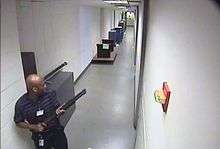
There is strong anecdotal evidence that CCTV aids in detection and conviction of offenders; indeed UK police forces routinely seek CCTV recordings after crimes.[32] Moreover, CCTV has played a crucial role in tracing the movements of suspects or victims and is widely regarded by antiterrorist officers as a fundamental tool in tracking terrorist suspects. Large-scale CCTV installations have played a key part of the defences against terrorism since the 1970s. Cameras have also been installed on public transport in the hope of deterring crime,[33][34] and in mobile police surveillance vehicles, often with automatic number plate recognition, and a network of APNI-linked cameras is used to manage London's congestion charging zone. Even so, there is political hostility to surveillance and several commentators downplay the evidence of CCTV's effectiveness, especially in the US.[35] However, most of these assertions are based on poor methodology or imperfect comparisons.[36]
A more open question is whether most CCTV is cost-effective. While low-quality domestic kits are cheap the professional installation and maintenance of high definition CCTV is expensive.[37] Gill and Spriggs did a Cost-effectiveness analysis (CEA) of CCTV in crime prevention that showed little monetary saving with the installation of CCTV as most of the crimes prevented resulted in little monetary loss.[38] Critics however noted that benefits of non-monetary value cannot be captured in a traditional Cost Effectiveness Analysis and were omitted from their study.[38] A 2008 Report by UK Police Chiefs concluded that only 3% of crimes were solved by CCTV.[39] In London, a Metropolitan Police report showed that in 2008 only one crime was solved per 1000 cameras.[40] In some cases CCTV cameras have become a target of attacks themselves.[41]
Cities such as Manchester in the UK are using DVR-based technology to improve accessibility for crime prevention.[42]
In October 2009, an "Internet Eyes" website was announced which would pay members of the public to view CCTV camera images from their homes and report any crimes they witnessed. The site aimed to add "more eyes" to cameras which might be insufficiently monitored. Civil liberties campaigners criticized the idea as "a distasteful and a worrying development".[43]
In 2013 Oaxaca hired deaf police officers to lip read conversations to uncover criminal conspiracies.[44]
In Singapore, since 2012, thousands of CCTV cameras have helped deter loan sharks, nab litterbugs and stop illegal parking, according to government figures.[45]
Body worn
In recent years, the use of body worn video cameras has been introduced for a number of uses. For example, as a new form of surveillance in law enforcement, with cameras located on a police officer's chest or head.[46][5]
Industrial processes
Industrial processes that take place under conditions dangerous for humans are today often supervised by CCTV. These are mainly processes in the chemical industry, the interior of reactors or facilities for manufacture of nuclear fuel. Special cameras for some of these purposes include line-scan cameras and thermographic cameras which allow operators to measure the temperature of the processes. The usage of CCTV in such processes is sometimes required by law.
Traffic monitoring
Many cities and motorway networks have extensive traffic-monitoring systems, using closed-circuit television to detect congestion and notice accidents.[47] Many of these cameras however, are owned by private companies and transmit data to drivers' GPS systems.
The UK Highways Agency has a publicly owned CCTV network of over 3000 Pan-Tilt-Zoom cameras covering the British motorway and trunk road network. These cameras are primarily used to monitor traffic conditions and are not used as speed cameras. With the addition of fixed cameras for the active traffic management system, the number of cameras on the Highways Agency's CCTV network is likely to increase significantly over the next few years.
The London congestion charge is enforced by cameras positioned at the boundaries of and inside the congestion charge zone, which automatically read the licence plates of cars. If the driver does not pay the charge then a fine will be imposed. Similar systems are being developed as a means of locating cars reported stolen.
Other surveillance cameras serve as traffic enforcement cameras.
Transport safety

A CCTV system may be installed where any example, on a Driver-only operated train CCTV cameras may allow the driver to confirm that people are clear of doors before closing them and starting the train.[48]
Sporting events
Many sporting events in the United States use CCTV inside the venue for fans to see the action while they are away from their seats. The cameras send the feed to a central control center where a producer selects feeds to send to the television monitors that fans can view. CCTV monitors for viewing the event by attendees are often placed in lounges, hallways, and restrooms. This use of CCTV is not used for surveillance purposes.
Monitor employees
Organizations use CCTV to monitor the actions of workers. Every action is recorded as an information block with subtitles that explain the performed operation. This helps to track the actions of workers, especially when they are making critical financial transactions, such as correcting or cancelling of a sale, withdrawing money or altering personal information.
Actions which an employer may wish to monitor could include:
- Scanning of goods, selection of goods, introduction of price and quantity;
- Input and output of operators in the system when entering passwords;
- Deleting operations and modifying existing documents;
- Implementation of certain operations, such as financial statements or operations with cash;
- Moving goods, revaluation scrapping and counting;
- Control in the kitchen of fast food restaurants;
- Change of settings, reports and other official functions.
Each of these operations is transmitted with a description, allowing detailed monitoring of all actions of the operator. Some systems allow the user to search for a specific event by time of occurrence and text description, and perform statistical evaluation of operator behaviour. This allows the software to predict deviations from the standard workflow and record only anomalous behaviour.[49]
Use in schools
In the United States, Britain,[50] Australia[51] and New Zealand, CCTV is widely used in schools due to its success in preventing bullying, vandalism, monitoring visitors and maintaining a record of evidence in the event of a crime. There are some restrictions on installation, with cameras not being installed in an area where there is a "reasonable expectation of privacy", such as bathrooms, gym locker areas and private offices (unless consent by the office occupant is given). Сameras are generally acceptable in hallways, parking lots, front offices where students, employees, and parents come and go, gymnasiums, cafeterias, supply rooms and classrooms. The installation of cameras in classrooms may be objected to by some teachers.[52]
Criminal use
Criminals may use surveillance cameras to monitor the public. For example, a hidden camera at an ATM can capture people's PINs as they are entered, without their knowledge. The devices are small enough not to be noticed, and are placed where they can monitor the keypad of the machine as people enter their PINs. Images may be transmitted wirelessly to the criminal. Even lawful surveillance cameras sometimes have their data go into the hands of people who have no legal right to receive it.[53]
Security
CCTV systems are often used for security monitoring purposes in organizations and homes.[54][55][56]
Prevalence
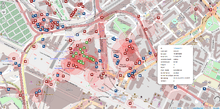
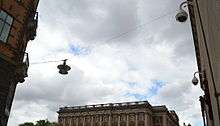

Worldwide
There are an estimated 350 million surveillance cameras worldwide as of 2016 compared with about 160 million in 2012. The growth of CCTV has been slowing in recent years.[8][note 1]
Asia
About 65% of CCTV cameras in the world are installed in Asia.[8] In Asia, different human activities attracted the use of surveillance camera systems and services, including but not limited to business and related industries, transportation,[59] sports,[60] and care for the environment.[61]
In 2018, China was reported to have a huge surveillance network of over 170 million CCTV cameras with 400 million new cameras expected be installed in the next three years, many of which use facial recognition technology.[62]
United States

There were an estimated 30 million surveillance cameras in the United States in 2011.[63] Video surveillance has been common in the United States since the 1990s; for example, one manufacturer reported net earnings of $120 million in 1995.[64] With lower cost and easier installation, sales of home security cameras increased in the early 21st century. Following the September 11 attacks, the use of video surveillance in public places became more common to deter future terrorist attacks.[23] Under the Homeland Security Grant Program, government grants are available for cities to install surveillance camera networks.[65][66][67] In 2009, there were an estimated 15,000 CCTV systems in Chicago, many linked to an integrated camera network.[68][69][70] New York City's Domain Awareness System has 6,000 video surveillance cameras linked together,[71] there are over 4,000 cameras on the subway system (although nearly half of them do not work),[72] and two-thirds of large apartment and commercial buildings use video surveillance cameras.[73][74] In the Washington D.C.-area, there are more than 30,000 surveillance cameras in schools,[75] and the Metro has nearly 6,000 cameras in use across the system.[76]
United Kingdom
In the United Kingdom, the vast majority of CCTV cameras are not operated by government bodies, but by private individuals or companies, especially to monitor the interiors of shops and businesses. According to 2011 Freedom of Information Act requests, the total number of local government operated CCTV cameras was around 52,000 over the entirety of the UK.[77]
Although specific legalities of running a home CCTV system in the UK are rather vague there are published [78] rules and regulations that although are mostly common sense, do include some laws that most people may not be aware of, including registering with ICO as a data controller if any CCTV camera catch images of any of the public on, or outside of your property.
An article published in CCTV Image magazine estimated the number of private and local government operated cameras in the United Kingdom was 1.85 million in 2011. The estimate was based on extrapolating from a comprehensive survey of public and private cameras within the Cheshire Constabulary jurisdiction. This works out as an average of one camera for every 32 people in the UK, although the density of cameras varies greatly from place to place. The Cheshire report also claims that the average person on a typical day would be seen by 70 CCTV cameras.[79]
The Cheshire figure is regarded as more dependable than a previous study by Michael McCahill and Clive Norris of UrbanEye published in 2002.[79][80] Based on a small sample in Putney High Street, McCahill and Norris extrapolated the number of surveillance cameras in Greater London to be around 500,000 and the total number of cameras in the UK to be around 4,200,000. According to their estimate the UK has one camera for every 14 people. Although it has been acknowledged for several years that the methodology behind this figure is flawed,[81] it has been widely quoted. Furthermore, the figure of 500,000 for Greater London is often confused with the figure for the police and local government operated cameras in the City of London, which was about 650 in 2011.[77]
The CCTV User Group estimated that there were around 1.5 million private and local government CCTV cameras in city centres, stations, airports, and major retail areas in the UK.[82] This figure does not include the smaller surveillance systems such as those that may be found in local corner shops and is therefore broadly in line with the Cheshire report.
Research conducted by the Scottish Centre for Crime and Justice Research and based on a survey of all Scottish local authorities, identified that there are over 2,200 public space CCTV cameras in Scotland.[83]
Defra made it legal in 2017 to have all Abbatoirs in the UK now covered by CCTV to prevent cruelty to animals during the slaughter process.[84]
Canada
Project SCRAM is a policing effort by the Halton Regional Police Service to register and help consumers understand the complex issues of privacy and safety that confront households when dealing with installations of home security systems. "The SCRAM program enables community members to voluntarily identify and register their residential video surveillance equipment through a simple, secure, confidential, online form.".[85] It has not been extended to commercial businesses. A wide-ranging effort to provide registration and monitoring of home security and systems. "Security camera registration and monitoring is a community-based crime prevention opportunity and investigative tool that enlists the help of residents and can help prevent crime on three levels. Residential video surveillance cameras can deter criminals from entering the area, can prevent crimes from occurring and help solve crimes by providing valuable evidence to the police."[85]
South Africa
In South Africa due to the high crime rate CCTV surveillance is widely prevalent but the country has been slow to implement the latest technology e.g. the first IP camera was released in 1996 by Axis Communications but IP cameras didn't arrive in South Africa till 2008.[86] In order to regulate the number of suppliers in 2001 the Private Security Industry Regulation Act was passed requiring all security companies to be registered with the Private Security Industry Regulatory Authority (PSIRA).[87]
Latin America
In Latin America, the CCTV market is growing rapidly with the increase of property crime.[88]
Video surveillance and terrorism
Material collected by surveillance cameras has been used as a tool in post-event forensics to identify tactics, techniques and perpetrators of terrorist attacks. Furthermore, there are various projects − such as INDECT − that aim to detect suspicious behaviours of individuals and crowds.[89] It has been argued that terrorists won't be deterred by cameras, that terror attacks aren't really the subject of the current use of video surveillance and that terrorists might even see it as an extra channel for propaganda and publication of their acts.[90][91] In Germany calls for extended video surveillance by the country's main political parties, SPD, CDU and CSU have been dismissed as "little more than a placebo for a subjective feeling of security".[92]
Privacy
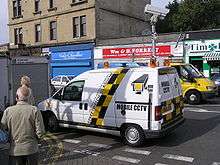
Many civil liberties campaign groups, academics and consultants have published research papers into CCTV systems. Opponents of CCTV point out the loss of privacy of people under surveillance, and the negative impact of surveillance on civil liberties. Furthermore, they argue that CCTV displaces crime, rather than reducing it. Critics often dub CCTV as "Big Brother surveillance", a reference to George Orwell's novel Nineteen Eighty-Four, which featured a two-way telescreen in every home through which The Party would monitor the populace.
Proponents of CCTV cameras argue that cameras are effective at deterring and solving crime, and that appropriate regulation and legal restrictions on surveillance of public spaces can provide sufficient protections so that an individual's right to privacy can reasonably be weighed against the benefits of surveillance.[93][94][95] However, anti-surveillance activists have held that there is a right to privacy in public areas. Furthermore, while it is true that there may be scenarios wherein a person's right to public privacy can be both reasonably and justifiably compromised, some scholars have argued that such situations are so rare as to not sufficiently warrant the frequent compromising of public privacy rights that occurs in regions with widespread CCTV surveillance. For example, in her book Setting the Watch: Privacy and the Ethics of CCTV Surveillance, Beatrice von Silva-Tarouca Larsen argues that CCTV surveillance is ethically permissible only in "certain restrictively defined situations", such as when a specific location has a "comprehensively documented and significant criminal threat".[96] Her central reasoning is that widespread CCTV surveillance violates citizens' rights to privacy and anonymity within the public sphere by jeopardizing both their liberty and dignity. She concludes that CCTV surveillance should therefore be reserved for specific circumstances in which there are clear and reasonably demonstrated benefits to its implementation and few ethical compromises.
In the United States, the Constitution does not explicitly include the right to privacy although the Supreme Court has said several of the amendments to the Constitution implicitly grant this right.[97] Access to video surveillance recordings may require a judge's writ, which is readily available.[98] However, there is little legislation and regulation specific to video surveillance.[99][100]
All countries in the European Union are signatories to the European Convention on Human Rights which protects individual rights including the right to privacy. The EU's Data Protection Directive regulates access to personal data including CCTV recordings.[101] This directive is translated into the national law of each country within the European Union.
In the United Kingdom the Data Protection Act 1998 imposes legal restrictions on the uses of CCTV recordings and mandates the registration of CCTV systems with the Data Protection Agency. In 2004, the successor to the Data Protection Agency, the Information Commissioner's Office clarified that this required registration of all CCTV systems with the Commissioner, and prompt deletion of archived recordings. However, subsequent case law (Durant vs. FSA) limited the scope of the protection provided by this law, and not all CCTV systems are currently regulated.[102] Nonetheless, private sector personnel in the UK who operate or monitor CCTV devices or systems are considered security guards and have been made subject to state licensing.
A 2007 report by the UK Information Commissioner's Office, highlighted the need for the public to be made more aware of the growing use of surveillance and the potential impact on civil liberties.[103][104] In the same year, a campaign group claimed the majority of CCTV cameras in the UK are operated illegally or are in breach of privacy guidelines.[105] In response, the Information Commissioner's Office rebutted the claim and added that any reported abuses of the Data Protection Act are swiftly investigated.[105] Even if there are some concerns arising from the use of CCTV such as involving privacy,[106] more commercial establishments are still installing CCTV systems in the UK.
In 2012, the UK government enacted the Protection of Freedoms Act which includes several provisions related to controlling and restricting the collection, storage, retention, and use of information about individuals. Under this Act, the Home Office published a code of practice in 2013 for the use of surveillance cameras by government and local authorities. The aim of the code is to help ensure their use is "characterised as surveillance by consent, and such consent on the part of the community must be informed consent and not assumed by a system operator. Surveillance by consent should be regarded as analogous to policing by consent."[107]
In Canada, the use of video surveillance has grown very rapidly. In Ontario, both the municipal and provincial versions of the Freedom of Information and Protection of Privacy Act outline very specific guidelines that control how images and information can be gathered by this method and or released.[108]
In Sweden, the use of CCTV in public spaces is nationally regulated; requiring permits for any operator (incl. Swedish Police Authority) to install CCTV in public spaces. In an opinion poll commissioned by Lund University in August 2017, the general public of Sweden were asked to choose one measure that would ensure their need for privacy when subject to CCTV-operation in public spaces. 43% favored regulation in the form of clear routines for managing, storing and distributing image material generated from surveillance cameras, 39% favored regulation in the form of clear signage informing that camera surveillance in public spaces is present, 2% favored regulation in the form of having permits restricting the use of surveillance cameras during certain times of day/week, 10% favored regulation in the form of having restrictive policies for issuing permits for surveillance cameras in public spaces. 6% were unsure or did not know.[109]
Technological developments

Computer-controlled analytics and identification
Computer-controlled cameras can identify, track, and categorize objects in their field of view.
Video content analysis (VCA) is the capability of automatically analyzing video to detect and determine temporal events not based on a single image, but rather object classification.[110] As such, it can be seen as the automated equivalent of the biological visual cortex.
A system using VCA can recognize changes in the environment and even identify and compare objects in the database using size, speed, and sometimes colour. The camera's actions can be programmed based on what it is "seeing". For example; an alarm can be issued if an object has moved in a certain area, or if a painting is missing from a wall, or if a smoke or fire is detected, or if running people are detected, or if fallen people are detected and if someone has spray painted the lens, as well as video loss, lens cover, defocus and other so called camera tampering events.
VCA analytics can also be used to detect unusual patterns in an environment. The system can be set to detect anomalies in a crowd, for instance a person moving in the opposite direction in airports where passengers are supposed to walk only in one direction out of a plane or in a subway where people are not supposed to exit through the entrances.[111]
VCA can track people on a map by calculating their position from the images. It is then possible to link many cameras and track a person through an entire building or area. This can allow a person to be followed without having to analyze many hours of film. Currently the cameras have difficulty identifying individuals from video alone, but if connected to a key-card system, identities can be established and displayed as a tag over their heads on the video.
There is also a significant difference in where the VCA technology is placed, either the data is being processed within the cameras (on the edge) or by a centralized server. Both technologies have their pros and cons.[112]
A facial recognition system is a computer application for automatically identifying or verifying a person from a digital image or a video frame from a video source. One of the ways to do this is by comparing selected facial features from the image and a facial database.
The combination of CCTV and facial recognition has been tried as a form of mass surveillance, but has been ineffective because of the low discriminating power of facial recognition technology and the very high number of false positives generated. This type of system has been proposed to compare faces at airports and seaports with those of suspected terrorists or other undesirable entrants.
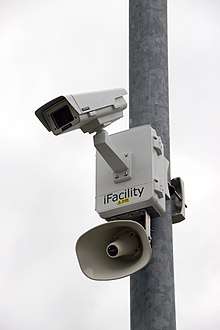
Computerized monitoring of CCTV images is under development, so that a human CCTV operator does not have to endlessly look at all the screens, allowing an operator to observe many more CCTV cameras. These systems do not observe people directly. Insta Types of body-movement behavior, or particular types of clothing or baggage.
To many, the development of CCTV in public areas, linked to computer databases of people's pictures and identity, presents a serious breach of civil liberties. Conservative critics fear the possibility that one would no longer have anonymity in public places.[113] Demonstrations or assemblies in public places could be affected as the state would be able to collate lists of those leading them, taking part, or even just talking with protesters in the street.
Comparatively harmless are people counter systems. They use CCTV equipment as front end eyes of devices which perform shape recognition technology in order to identify objects as human beings and count people passing pre-defined areas.
Retention, storage and preservation
Most CCTV systems may record and store digital video and images to a digital video recorder (DVR) or, in the case of IP cameras, directly to a server, either on-site or offsite.[114]
There is a cost in the retention of the images produced by CCTV systems. The amount and quality of data stored on storage media is subject to compression ratios, images stored per second, image size and is effected by the retention period of the videos or images.[115] DVRs store images in a variety of proprietary file formats. Recordings may be retained for a preset amount of time and then automatically archived, overwritten or deleted, the period being determined by the organisation that generated them.
Closed-circuit digital photography (CCDP)[116]
Closed-circuit digital photography (CCDP) is more suited for capturing and saving recorded high-resolution photographs, whereas closed-circuit television (CCTV) is more suitable for live-monitoring purposes.
However, an important feature of some CCTV systems is the ability to take high resolution images of the camera scene, e.g. on a time lapse or motion-detection basis. Images taken with a digital still camera often have higher resolution than those taken with some video cameras. Increasingly, low-cost high-resolution digital still cameras can also be used for CCTV purposes.
Images may be monitored remotely when the computer is connected to a network.
IP cameras
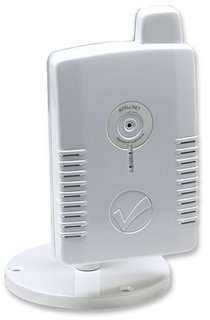
A growing branch in CCTV is internet protocol cameras (IP cameras). It is estimated that 2014 was the first year that IP cameras outsold analog cameras.[117] IP cameras use the Internet Protocol (IP) used by most Local Area Networks (LANs) to transmit video across data networks in digital form. IP can optionally be transmitted across the public internet, allowing users to view their cameras through any internet connection available through a computer or a phone, this is considered remote access. For professional or public infrastructure security applications, IP video is restricted to within a private network or VPN,[118] or can be recorded onto a remote server.
Networking CCTV cameras
The city of Chicago operates a networked video surveillance system which combines CCTV video feeds of government agencies with those of the private sector, installed in city buses, businesses, public schools, subway stations, housing projects etc.[119] Even homeowners are able to contribute footage. It is estimated to incorporate the video feeds of a total of 15,000 cameras.[120]
The system is used by Chicago's Office of Emergency Management in case of an emergency call: it detects the caller's location and instantly displays the real-time video feed of the nearest security camera to the operator, not requiring any user intervention. While the system is far too vast to allow complete real-time monitoring, it stores the video data for later usage in order to provide possible evidence in criminal cases.[121]
New York City has a similar network called the Domain Awareness System.
London also has a network of CCTV systems that allows multiple authorities to view and control CCTV cameras in real time. The system allows authorities including the Metropolitan Police Service, Transport for London and a number of London boroughs to share CCTV images between them. It uses a network protocol called Television Network Protocol to allow access to many more cameras than each individual system owner could afford to run and maintain.
The Glynn County Police Department uses a wireless mesh-networked system of portable battery-powered tripods for live megapixel video surveillance and central monitoring of tactical police situations. The systems can be used either on a stand-alone basis with secure communications to nearby police laptops, or within a larger mesh system with multiple tripods feeding video back to the command vehicle via wireless, and to police headquarters via 3G.
Integrated systems

Integrated systems allow different security systems, like CCTV, access control, intruder alarms and intercoms to operate together. For example, when an intruder alarm is activated, CCTV cameras covering the intrusion area are recorded at a higher frame rate and transmitted to an Alarm Receiving Centre.
Wireless security cameras
Many consumers are turning to wireless security cameras for home surveillance. Wireless cameras do not require a video cable for video/audio transmission, simply a cable for power. Wireless cameras are also easy and inexpensive to install, but lack the reliability of hard-wired cameras.[122] Previous generations of wireless security cameras relied on analog technology; modern wireless cameras use digital technology which delivers crisper audio, sharper video, and a secure and interference-free signal.[123]
Talking CCTV
In Wiltshire, UK, 2003, a pilot scheme for what is now known as "Talking CCTV" was put into action; allowing operators of CCTV cameras to order offenders to stop what they were doing, ranging from ordering subjects to pick up their rubbish and put it in a bin to ordering groups of vandals to disperse. In 2005 Ray Mallon, the mayor and former senior police officer of Middlesbrough implemented "Talking CCTV" in his area.[124]
Other towns have had such cameras installed. In 2007 several of the devices were installed in Bridlington town centre, East Riding of Yorkshire.[125]
Countermeasures
Due to the widespread implementation of surveillance cameras, glasses are being built which can defeat CCTV cameras. In December 2016 a form of anti-CCTV and facial recognition sunglasses called 'reflectacles' were invented by a custom-spectacle-craftsmen based in Chicago named Scott Urban.[126] They reflect infrared and, optionally, visible light which makes the users face a white blur to cameras. The project easily surpassed its funding goal of $28,000 and reflectacles will be commercially available by June 2017.[127]
CCTV camera vandalism
Unless physically protected, CCTV cameras have been found to be vulnerable against a variety of (mostly illegal) tactics:
- Some people will deliberately destroy cameras. Some cameras can come with dust-tight, pressurized, explosion proof, and bullet-resistant housings.
- Spraying substances over the lens can make the image too blurry to view.
- Lasers can blind or damage them. However, since most lasers are monochromatic, color filters can reduce the effect of laser pointers. But filters also impair image quality and overall light sensitivity of cameras (see laser safety article for details on issues with filters). Also, complete protection from lasers of any wavelength would require use of completely black filters, rendering the camera useless.
Cost
The security camera installation cost in Los Angeles, United States ranges from US$300 to US$3,500. On average, however, the cost can be anywhere from US$893 – US$2,267. The price will go up depending on specific requirements or the extent of the security that will be required.
Factors affecting security camera installation cost
Among other factors, the specific type of camera being used has the most significant impact on its cost. The average cost of two digital cameras packaged with an LCD monitor is around US$450. Different brands can also have different prices. The type of technology used also has an impact of security camera installation cost. Wireless camera systems are generally more expensive than their wired counterparts.
The specific type of software that is being used also has a role to play on its price. On average, professional level software is offered at US$75, with some of them requiring annual fees for membership. Network attached storage or DVR, used for storing recorded video, will also be part of the cost. On average, that can cost about US$499. This will depend on the storage capacity and other features of the device chosen by the user.
See also
- Artificial intelligence for video surveillance
- Bugging
- Closed-circuit television camera
- Documentary practice
- Eye in the sky (camera)
- Fake security camera
- INDECT
- Information Awareness Office
- IP camera
- Motion (surveillance software)
- Optic Nerve (GCHQ)
- Physical security
- Physical security information management (PSIM)
- Privacy International
- Proprietary DVR
- Security operations center
- Security smoke
- Smart camera
- Sousveillance (inverse surveillance)
- Super recognisers
- Surveillance
- Telescreen
- The Convention on Modern Liberty
- TV Network Protocol
- Under vehicle inspection
- Video analytics
- Videotelephony
- Washington County Closed-Circuit Educational Television Project
- Webcam
Notes
References
- ↑ Kumar, Vikas; Svensson, Jakob, eds. (2015). Promoting Social Change and Democracy Through Information Technology. IGI Global. p. 75. ISBN 9781466685031.
- ↑ Dempsey, John S. (2008). Introduction to private security. Belmont, CA: Thomson Wadsworth. p. 78. ISBN 9780534558734.
- ↑ Verman, Romesh. Distance Education In Technological Age, Anmol Publications Pvt. Ltd., 2005, pp.166, ISBN 81-261-2210-2, ISBN 978-81-261-2210-3.
- ↑ "Distance education in Asia and the Pacific: Proceedings Of The Regional Seminar On Distance Education, 26 November - 3 December 1986", Asian Development Bank, Bangkok, Thailand, Volume 2, 1987
- 1 2 Hung, Esq.; Babin, MD; PhD.; Coberly, PhD., Vivian; Steven; Jacqueline. "A Market Survey on Body Worn Camera Technologies" (PDF). The Department of Justice's National Institute of Justice. Johns Hopkins University Applied Physics Laboratory.
- ↑ "What's wrong with public video surveillance?". ACLU. Retrieved 5 January 2017.
- ↑ "Surveillance Cameras and the Right to Privacy". CBS News. August 13, 2010. Retrieved 5 January 2017.
- 1 2 3 "Rise of Surveillance Camera Installed Base Slows". 5 May 2016. Retrieved 5 January 2017.
- ↑ Dornberger, Walter: V-2, Ballantine Books 1954, ASIN: B000P6L1ES, page 14.
- ↑ "ET_SRB Cam FS.indd" (PDF). Retrieved 2009-07-22.
- ↑ "Ecliptic Enterprises Corporation". Eclipticenterprises.com. Archived from the original on July 5, 2008. Retrieved 2009-05-08.
- ↑ CCTV recording systems are still often used at modern launch sites to record the flight of the rockets, in order to find the possible causes of malfunctions,[10][11] while larger rockets often send pictures of stage separation back to earth by radio link.
- ↑ "Television Rides Wires" , February 1949, Popular Science small article, bottom of page 179
- ↑ "CCTV Surveillance".
- 1 2 Roberts, Lucy. "History of Video Surveillance and CCTV" We C U Surveillance Retrieved 2011-10-20
- ↑ "Internet based CCTV on cloud services" (in Finnish). fennoturvapalvelut. March 27, 2015.
- 1 2 Ezra, Michael (2013). The Economic Civil Rights Movement: African Americans and the Struggle for Economic Power. Routledge. p. 105. ISBN 9781136274756.
- 1 2 3 "History of Prizefighting's Biggest Money Fights". Bloody Elbow. SB Nation. August 24, 2017.
- ↑ Television. Frederick A. Kugel Company. 1965. p. 78.
Teleprompter's main-spring, Irving B. Kahn (he's chairman of the board and president), had a taste of closed circuit operations as early as 1948. That summer, Kahn, then a vice president of 20th Century-Fox, negotiated what was probably the first inter-city closed circuit telecast in history, a pickup of the Joe Louis-Joe Walcott fight.
- ↑ "Zaire's fight promotion opens new gold mines". The Morning Herald. November 18, 1974.
- ↑ "Karriem Allah". Black Belt. Active Interest Media, Inc.: 35 1976.
- ↑ [Robb, Gary C. (1979) "Police Use of CCTV Surveillance: Constitutional Implications and Proposed Regulations" University of Michigan Journal of Law Reform. pg. 572]
- 1 2 3 4 5 6 [Yesil, Bilge. (2006) "Watching Ourselves" Cultural Studies. Vol 20(4-5) pg. 400-416]
- ↑ "You're being watched, New York!". BBC. 11 March 2002.
- ↑ Staff (August 2007). "CCTV". Borough Council of King's Lynn & West Norfolk. Archived from the original on 2009-05-23. Retrieved 2008-12-14.
- 1 2 "Public Area CCTV and Crime Prevention: An Updated Systematic Review and Meta-Analysis". Journalist's Resource.org.
- ↑ Zehnder (2009). = "The economics of subjective security and camera surveillance" Check
|url=value (help). - ↑ Priks, Mikael (2015-11-01). "The Effects of Surveillance Cameras on Crime: Evidence from the Stockholm Subway". The Economic Journal. 125 (588): F289–F305. doi:10.1111/ecoj.12327. ISSN 1468-0297.
- ↑ Stutzer (2013). "Is camera surveillance an effective measure of counterterrorism?". Defence and Peace Economics: 1–14. doi:10.1080/10242694.2011.650481.
- ↑ Alexandrie, Gustav (2017). "Surveillance cameras and crime: a review of randomized and natural experiments". Journal of Scandinavian Studies in Criminology and Crime Prevention. doi:10.1080/14043858.2017.1387410.
- ↑ "Orphaned Video System in Philadelphia?".
- ↑ "Police are failing to recover crucial CCTV footage, new figures suggest.," The Telegraph
- ↑ "CCTV to drive down cab attacks," BBC
- ↑ Taxi CCTV cameras are installed," BBC
- ↑ Baram, Marcus (2007-07-09). "Eye on the City: Do Cameras Reduce Crime?". ABC News. Retrieved 2007-07-10.
- ↑ "Tens of thousands of CCTV cameras, yet 80% of crime unsolved" by Justin Davenport 2007
- ↑ "National community Crime Prevention Programme" (PDF). Retrieved 2016-03-30.
- 1 2
- ↑ "Are CCTV cameras a waste of money in the fight against crime?" Forward Edge, 7 May 2008
- ↑ Hughe, Mark (25 August 2009). "CCTV in the spotlight: one crime solved for every 1,000 cameras". Independent News and Media Limited. Retrieved 2009-08-27.
- ↑ "http://news.bbc.co.uk/," BBC
- ↑ "Digital CCTV Scheme Switches On," BBC
- ↑ Public to Monitor CCTV From Home, BBC
- ↑ Angels of Silence see crime where others don't Globe & Mail, 20 Nov 2013
- ↑ "Network of CCTV cameras proving effective". www.straitstimes.com. Retrieved 2017-02-06.
- ↑ Bayley, David H.; Stenning, Philip C. (2016). Governing the Police: Experience in Six Democracies. Transaction Publishers. ISBN 1412862310.
- ↑ Motorway Cameras in England, http://www.motorwaycameras.co.uk
- ↑ FCC Train Dispatch training video, 2013-03-25, retrieved 2018-07-26 (Explains about DOO train dispatch it states about the use of CCTV monitors at certain stations at 7:35 in the video.)
- ↑ "Using CCTV to monitor the workplace | Small Business Update | Library | ICAEW". www.icaew.com. Retrieved 2016-09-18.
- ↑ ATL (22 October 2013). "Use of CCTV surveillance in schools". ATL the education union. Retrieved 8 November 2016.
- ↑ Bruce McDougall and Katherine Danks (28 March 2012). "School security CCTV puts bullies on pause". The Daily Telegraph. Retrieved 8 November 2016.
- ↑ "Legal aspects of the use of video cameras in schools =".
- ↑ "Benalla. Trois policiers suspendus pour avoir transmis des images de vidéosurveillance".
- ↑ Novak, Matt (June 26, 2012). "Surgery, Security and Sales: The Future of Closed-Circuit Television". Smithsonian.
- ↑ "Closed Circuit Television". The Museum of Broadcast Communications - Encyclopedia of Television -. Retrieved 1 July 2018.
- ↑ "Recommendations and Guidelines for Using Closed-Circuit Television Security Systems in Commercial Institutions". Scientific Working Group on Imaging Technology (SWGIT). 8 June 2012.
- ↑ khris78. "The CCTV Map". osmcamera. Archived from the original on 25 October 2014. Retrieved 2 August 2014.
- ↑ "The Video Surveillance Industry – Market size" (PDF). Cameramanager.com citing other industry sources. Retrieved 7 February 2015.
- ↑ "Australian state government to expand CCTV use across transport network". Archived from the original on 2015-04-02. Retrieved 2015-03-11.
- ↑ "Chinese TV station CCTV provide 'old school' analysis of AFC Asian Cup match". Retrieved 2015-03-11.
- ↑ "Indian state government uses CCTV to cut forest crimes". Archived from the original on 2014-10-11. Retrieved 2015-03-11.
- ↑ "Smart cameras catch man in 60,000 crowd". BBC News. 2018-04-13. Retrieved 2018-04-13.
- ↑ Technocreep : the surrender of privacy and the capitalization of intimacy. [S.l.]: Greystone Books. 2014. p. 28. ISBN 1771641223 ; "Surveillance Society: New High-Tech Cameras Are Watching You". Popular Mechanics. September 30, 2009. Retrieved October 31, 2015 ; "Lawmakers want more surveillance on the ground -- and in the sky". NBC News. April 20, 2013. Retrieved October 31, 2015 ; Dempsey, John; Forst, Linda (2015). An Introduction to Policing. Cengage Learning. p. 485. ISBN 9781305544680.
- ↑ "Public Video Surveillance: Is It An Effective Crime Prevention Tool?". California Research Bureau. June 1997. Retrieved 5 February 2015.
The popularity of CCTV security systems has not gone unnoticed by the manufacturers of camera surveillance systems. ...A leading CCTV manufacturer reported net earnings of $120 million in 1995, compared with net earnings of $16 million the previous year. ...Over 50 percent of all CCTV surveillance equipment sales are to industrial and commercial clients. CCTV surveillance is also very common in the American workplace.
- ↑ Minoli, Daniel (2013). Building the internet of things with IPv6 and MIPv6 the evolving world of M2M communications. New Jersey: Wiley. p. 86. ISBN 9781118647134.
- ↑ "The great surveillance boom". Fortune. 26 April 2013. Retrieved 24 January 2016.
- ↑ "Privacy Fears Grow as Cities Increase Surveillance". The New York Times. October 13, 2013. Retrieved 5 January 2017.
- ↑ "Chicago's Camera Network Is Everywhere". Wall Street Journal. November 17, 2009. Retrieved 5 January 2017.
- ↑ "Chicago Links Police, Private Cameras". WLS-TV. 2010. Retrieved 2010-08-16.
- ↑ "Chicago's Video SURVEILLANCE CAMERAS: A PERVASIVE AND UNREGULATED THREAT TO OUR PRIVACY" (PDF). ACLU of Illinois. February 2011. Retrieved 5 January 2017.
- ↑ "NYPD expands surveillance net to fight crime as well as terrorism". Reuters. June 21, 2013. Retrieved October 31, 2015.
- ↑ "Lack of Video Slows Hunt for a Killer in the Subway". The New York Times. March 29, 2010. Retrieved October 31, 2015.
- ↑ "The State Of Surveillance". Bloomberg Business. August 7, 2005. Retrieved October 31, 2015.
- ↑ "The Building Has 1,000 Eyes". The New York Times. October 4, 2013. Retrieved 5 January 2017.
- ↑ "30,000 Surveillance Cameras Monitor D.C.-Area Public Schools". NBC Washington. January 1, 2015. Retrieved 31 October 2015.
- ↑ "Metro Plans to Triple Number of Security Cameras". NBC Washington. April 1, 2013. Retrieved October 31, 2015.
- 1 2 "The Price of Privacy: How local authorities spent £515m on CCTV in four years" (PDF). Big Brother Watch. February 2012. p. 30. Retrieved 4 February 2015.
- ↑ "Rules and Regulations of Home CCTV installation - iFacility 01749 600600". 15 March 2017.
- 1 2 "You're being watched: there's one CCTV camera for every 32 people in UK - Research shows 1.85m machines across Britain, most of them indoors and privately operated". The Guardian. 2 March 2011. Retrieved 7 January 2017 ;
- ↑ "CCTV in London" (PDF). Retrieved 22 July 2009.
- ↑ "FactCheck: how many CCTV cameras?". Channel 4 News. 18 June 2008. Retrieved 8 May 2009.
- ↑ "How many cameras are there?". CCTV User Group. 18 June 2008. Retrieved 8 May 2009.
- ↑ Bannister, J., Mackenzie, S. and Norris, P. Public Space CCTV in Scotland(2009), Scottish Centre for Crime and Justice Research (Research Report)
- ↑ "Abattoir CCTV Installation Company - NSI Gold iFacility".
- 1 2 One Vision, One Mission, One Team Archived January 14, 2016, at the Wayback Machine.(2014), Halton Regional Police Service
- ↑ "CCTV Systems". Retrieved 24 February 2017.
- ↑ "PSIRA ACT" (PDF). Private Security Industry Regulatory Authority. 2002-02-25. Retrieved 2016-10-12.
- ↑ "Latin American Physical Security Market Growing Rapidly," 8 October 2009 Security Magazine
- ↑ Mould, Nick; Regens, James L.; Jensen, Carl J.; Edger, David N. (30 August 2014). "Video surveillance and counterterrorism: the application of suspicious activity recognition in visual surveillance systems to counterterrorism". Journal of Policing, Intelligence and Counter Terrorism. 9 (2): 151–175. doi:10.1080/18335330.2014.940819.
- ↑ "In the Petabyte Age of Surveillance, Software Polices". Popular Mechanics. 10 May 2010. Retrieved 4 January 2017.
- ↑ "Mehr Videoüberwachung gegen Terroristen - WDR aktuell - Sendung - Video - Mediathek - WDR". WDR. 26 October 2016. Retrieved 4 January 2017.
- ↑ "Calls increase for sweeping surveillance after Berlin attack". Deutsche Welle. Retrieved 4 January 2017.
- ↑ Kroener, Inga (2014). CCTV: A Technology Under the Radar?. Ashgate Publishing. ISBN 9781472400963.
- ↑ "Video Surveillance of Public Places: Response Guide No. 4 (2006)". Center for Problem-Oriented Policing. 2006. Retrieved 25 January 2016.
- ↑ Smile, the cameras are here to watch over you - The New Zealand Herald, Tuesday 18 March 2008, Page A14
- ↑ Von Silva-Tarouca Larsen, Beatrice (2011). Setting the watch: Privacy and the ethics of CCTV surveillance. Hart Publishing. p. 160. ISBN 978-1849460842.
- ↑ "Your Right to Privacy". American Civil Liberties Union. Retrieved 24 January 2016.
- ↑ Department of Justice - Video Surveillance Retrieved August 6, 1982
- ↑ "What's Wrong With Public Video Surveillance". American Civil Liberties Union. Retrieved 24 January 2016.
- ↑ Kroener, Inga (2014). CCTV: A Technology Under the Radar?. Ashgate Publishing. p. 110. ISBN 9781472400963.
- ↑ Kroener, Inga (2014). CCTV: A Technology Under the Radar?. Ashgate Publishing. p. 107. ISBN 9781472400963.
- ↑ "Memorandum by A A Adams, BSc, MSc, PhD, LLM, MBCS, CITP School of Systems Engineering". UK Parliament Constitution Committee - Written Evidence. Surveillance: Citizens and the State. January 2007.
- ↑ "Privacy watchdog wants curbs on surveillance". The Telegraph. 1 May 2007.
- ↑ "CCTV, computers and the 'climate of fear'". Evening Standard. 30 April 2007.
- 1 2 "Majority of UK's CCTV cameras 'are illegal'". The Telegraph. 31 May 2007.
- ↑ "Home surveillance CCTV images may breach data protection laws, ECJ rules". Retrieved 2015-03-11.
- ↑ "Surveillance Camera Code of Practice" (PDF). UK Government Home Office. June 2013. p. 5. Retrieved 1 December 2013.
- ↑ Freedom of Information and Protection of Privacy Act Archived September 24, 2007, at the Wayback Machine. Text
- ↑ Lahtinen, Markus (2017). "The perception of surveillance cameras and privacy among the general public in Sweden" (PDF). LUSAX-research group, Lund University School of Economics and Management, Sweden.
- ↑ 2018 9th International Conference on Information and Communication Systems (ICICS) : 3-5 April, 2018, Jordan University of Science and Technology, Irbid, Jordan. Jordan University of Science & Technology,, Institute of Electrical and Electronics Engineers. Jordan Section,, Institute of Electrical and Electronics Engineers,. [Piscataway, New Jersey]. ISBN 9781538643662. OCLC 1037097519.
- ↑ "MATE's Analytics Integrate with Hirsch Security Systems". Archived from the original on 2009-02-16. Retrieved 2011-03-28.
- ↑ "Image Processing Techniques for Video Content Extraction" (PDF). Retrieved 2011-03-28.
- ↑ Todd Lewan (July 7, 2007). "Microchips in humans spark privacy debate". USAToday. Retrieved 2012-06-07.
- ↑ "CCTV Systems for a greater future home & business security". CTS Systems Latest News. 2017-11-28. Retrieved 2017-12-19.
- ↑ "MotionJPEG, JPEG2000, H.264 and MPEG-4 compression methods in CCTV". Retrieved 2011-05-01.
- ↑ "CCTV Systems for a greater future home & business security". CTS Systems. 2017-11-28. Retrieved 2017-12-19.
- ↑ "Global value of IP camera sales now close to 50% of CCTV cameras sold, but..."
- ↑ "Dispelling the Top 10 Myths of IP Surveillance" (PDF). Retrieved 30 March 2016.
- ↑ "The City of Chicago's OEMC and IBM Launch Advanced Video Surveillance System". IBM News Room. Retrieved 30 March 2016.
- ↑ Bulkeley, William M. "Chicago's Camera Network Is Everywhere". Wall Street Journal. ISSN 0099-9660. Retrieved 2016-03-30.
- ↑ "Chicago's Camera Network Is Everywhere", The Wall Street Journal
- ↑ "2012".
- ↑ Digital Video Essentials: Shoot, Transfer, Edit, Share By Erica Sadun. Retrieved 16 October 2013.
- ↑ "BBC NEWS - UK - England - Tees - Town trials talking CCTV cameras".
- ↑ "BBC NEWS - UK - England - Humber - 'Talking' CCTV cameras are tested".
- ↑ "Be Seen and Unseen! Reflectacles are the Sunglasses of the Future".
- ↑ "Reflectacles - Reflective Eyewear and Sunglasses". Kickstarter.
Further reading
- Armstrong, Gary, ed. (1999). The maximum surveillance society: the rise of CCTV. Berg (originally, University of Michigan Press). ISBN 9781859732212.
- Fyfe, Nicholas; Bannister, Jon (2005). "City Watching: Closed-Circuit Television in Public Spaces". In Fyfe, Nicholas & Kenny, Judith T. The Urban Geography Reader. Psychology Press. ISBN 9780415307017.
- Newburn, Tim & Hayman, Stephanie (2001). Policing, Surveillance and Social Control: CCTV and police monitoring of suspects. Taylor & Francis. ISBN 9781843924692.
- Norris, Clive (2003). "From Personal to Digital: CCTV, the panopticon, and the technological mediation of suspicion and social control". In Lyon, David. Surveillance as Social Sorting: Privacy, Risk, and Digital Discrimination. Psychology Press. ISBN 9780415278737.
- "IP Camera". Stopdedief.be.
External links
| Wikimedia Commons has media related to Closed-circuit television (CCTV). |
